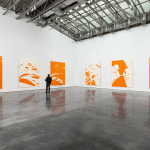
At The Brooklyn Rail this month, Elizabeth Baker, former editor of Art in America, served as guest editor to the Art section, asking contributors to consider the question, “What’s new?” Writing in her introduction she suggested that
Among the artists, words like “progress,” “innovation,” and “originality” barely crop up. Yet it’s clear that today’s artists are taking the conditions of the art world and the society in which they live and finding ways to make art that is distinctly their own. That, for them, is what “new” means. Perhaps it’s time to give up the expectation of a millennial eruption of novel forms and/or strategies and look critically and carefully at what actually surrounds us.
In a review of Michelle Segre’s show at Derek Eller, I considered the fashionable cult of bigness and super-monumentalism.
“A great deal of recent art found in global biennials and blue-chip galleries (think of Damien Hirst’s spots or Kehinde Wiley’s portraits) is made by teams of acolytes under an art superstar’s supervision. By definition, this kind of outsourcing is not possible unless the work is formulaic, which means the artist must subordinate the risk-taking, experimental phase of the artmaking process, the stage in which an artist asks the simple question “What if?” Replacing this is a corporate model that implicitly values production and efficiency over inspiration and insight. In a recent Art in America article, Ossian Ward suggests that these marquee artists, making ever bigger and more extravagant projects, are engaged in a kind of super-monumentalism. “I think artist colleagues fear that they will be pushed in the corner and forgotten,” Thomas Schutte tells Ward.”It’s competing with Hollywood: Who has got the biggest? Who has the longest? Who is the richest?
“Arguably, the inner need for discovery that compelled the artists to make art in the first place has given way to a penchant for spectacle. For artists working in this theatrical mode, making work is about many things — ensuring placement in museums and prominent collections, perpetuating fame, maintaining a lifestyle — but perhaps not so much about the work itself. There is no question what the materials will be used for. The final outcome is a given.
“From this perspective, Michelle Segre is gratifyingly old-school. The question “What if?” permeates each piece in Lost Songs of the Filament, her affably invigorating installation at Derek Eller. Large-scale, idiosyncratic sculptures handmade with wire, thread, metal mesh…” READ MORE.
——-
Subscribe to Two Coats of Paint by email.























That's amazing! I love it!
Arguably, the inner need for discovery that compelled the artists to make art in the first place has given way to a penchant for spectacle.
It's also a matter of art history, we've been sold a rosalind Kraus narrative that has broken down. Artists like a Mike Kelley attempted to co opt that narrative to open other ways of thinking. Our culture is nothing but one huge spectacle so it's hard to avoid kulture critique so as not to look marginalized. I'm not seeing the work here as spectacle-free either.